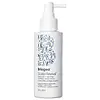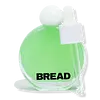What's inside
What's inside
 Key Ingredients
Key Ingredients

 Benefits
Benefits

 Concerns
Concerns

 Ingredients Side-by-side
Ingredients Side-by-side

Water
Skin ConditioningPropanediol
SolventArginine
MaskingBetaine
HumectantSalicylic Acid
MaskingLactic Acid
BufferingGluconolactone
Skin ConditioningMelaleuca Alternifolia Leaf Oil
AntioxidantMentha Piperita Oil
MaskingSodium PCA
HumectantPanthenol
Skin ConditioningHyaluronic Acid
HumectantCharcoal Powder
AbrasivePolyglyceryl-4 Caprate
EmulsifyingMethyl Diisopropyl Propionamide
MaskingZingiber Officinale Root Oil
MaskingBenzyl Alcohol
PerfumingWater
Skin ConditioningBrassica Oleracea Italica Sprout Extract
EmollientGluconolactone
Skin ConditioningCoffea Arabica Leaf/Seed Extract
MaskingMelia Azadirachta Leaf Extract
Skin ConditioningMelia Azadirachta Flower Extract
Skin ConditioningSerenoa Serrulata Fruit Extract
Skin ConditioningPrunus Serrulata Flower Extract
Skin ConditioningPalmaria Palmata Extract
Skin ProtectingDavidsonia Jerseyana Fruit Extract
AntioxidantAnanas Sativus Fruit Extract
Skin ConditioningHelianthus Annuus Seed Extract
Skin ConditioningCupressus Sempervirens Leaf/Stem Extract
Skin ConditioningCentella Asiatica Extract
CleansingCamellia Sinensis Leaf Extract
AntimicrobialBackhousia Anisata Leaf Extract
EmollientScutellaria Baicalensis Root Extract
AstringentTriticum Vulgare Germ Extract
Skin ConditioningGlycine Soja Germ Extract
EmollientCoenochloris Signiensis Extract
Skin ConditioningGlycerin
HumectantArginine
MaskingLactic Acid
BufferingTocopherol
AntioxidantHydroxyethylcellulose
Emulsion StabilisingEthylhexylglycerin
Skin ConditioningPropanediol
SolventMandelic Acid
AntimicrobialMaltodextrin
AbsorbentMenthol
MaskingMenthyl Lactate
MaskingSodium Nitrate
SoothingPolysorbate 60
EmulsifyingDisodium Phosphate
BufferingMenthone
PerfumingLimonene
PerfumingL-Menthanone
PerfumingEucalyptol
PerfumingD-Pulegone
PerfumingBeta-Caryophyllene
MaskingNeomenthol
PerfumingSodium Phosphate
BufferingPinene
MaskingSodium Benzoate
MaskingLecithin
EmollientGlyoxal
AntimicrobialCalcium Gluconate
HumectantPhenoxyethanol
PreservativeWater, Brassica Oleracea Italica Sprout Extract, Gluconolactone, Coffea Arabica Leaf/Seed Extract, Melia Azadirachta Leaf Extract, Melia Azadirachta Flower Extract, Serenoa Serrulata Fruit Extract, Prunus Serrulata Flower Extract, Palmaria Palmata Extract, Davidsonia Jerseyana Fruit Extract, Ananas Sativus Fruit Extract, Helianthus Annuus Seed Extract, Cupressus Sempervirens Leaf/Stem Extract, Centella Asiatica Extract, Camellia Sinensis Leaf Extract, Backhousia Anisata Leaf Extract, Scutellaria Baicalensis Root Extract, Triticum Vulgare Germ Extract, Glycine Soja Germ Extract, Coenochloris Signiensis Extract, Glycerin, Arginine, Lactic Acid, Tocopherol, Hydroxyethylcellulose, Ethylhexylglycerin, Propanediol, Mandelic Acid, Maltodextrin, Menthol, Menthyl Lactate, Sodium Nitrate, Polysorbate 60, Disodium Phosphate, Menthone, Limonene, L-Menthanone, Eucalyptol, D-Pulegone, Beta-Caryophyllene, Neomenthol, Sodium Phosphate, Pinene, Sodium Benzoate, Lecithin, Glyoxal, Calcium Gluconate, Phenoxyethanol
Alternatives
Ingredients Explained
These ingredients are found in both products.
Ingredients higher up in an ingredient list are typically present in a larger amount.
Arginine is an amino acid that is important for human development. Your body uses is it to produce hair keratin and skin collagen.
As a cosmetic ingredient, Arginine has antioxidant properties and can also help repair damaged skin. This ingredient is derived either synthetically or from animals.
Arginine isn't fungal acne safe when used in the presence of other lipids (fats, fatty acids, oils, esters, etc). Oils and fats occur naturally within the skin, so take caution when using Arginine if you're prone to fungal acne.
Learn more about ArginineGluconolactone is a PHA. PHAs are a great gentle alternative to traditional AHAs.
When applied, Gluconolactone has the same affect on skin as AHAs such as lactic acid. It helps dissolve the dead skin cells in the top layer of your skin. This improves texture and brightens the skin.
PHAs are more gentle than AHAs due to their larger structure. They do not penetrate as deeply as AHAs and take a longer time to dissolve dead cells. Studies show PHAs do not cause as much irritation.
Gluconolactone has some interesting properties:
In a 2004 study, Gluconolactone was found to prevent UV damage in mouse skin cells and has not been found to increase sun sensitivity. However, we still recommend wearing SPF daily.
This ingredient is is an created by reacting gluconic acid with an alcohol.
Learn more about GluconolactoneLactic Acid is another well-loved alpha hydroxy acid (AHA). It is gentler than glycolic acid but still highly effective.
Its main role is to exfoliate the surface of the skin by loosening the “glue” that holds dead skin cells together. Shedding those old cells leads to smoother, softer, and more even-toned skin.
Because lactic acid molecules are larger than glycolic acid, they don’t penetrate as deeply. This means they’re less likely to sting or irritate, making it a great choice for beginners or those with sensitive skin.
Like glycolic acid, it can:
Lactic acid also acts as a humectant (like hyaluronic acid). It can draw water into the skin to improve hydration and also plays a role in the skin's natural moisturizing factor (NMF) in the form of sodium lactate.
Studies show it can boost ceramide production to strengthen the skin barrier and even help balance the skin’s microbiome.
To get results, choose products with a pH between 3-4.
Lower strengths (5-12%) focus on surface exfoliation; higher strengths (12% and up) can reach deeper in the dermis (deeper, supportive layer) to improve skin texture and firmness over time.
Though it was originally derived from milk, most modern lactic acid used in skincare is vegan. It is made through non-dairy fermentation to create a bio-identical and stable form suitable for all formulations.
When lactic acid shows up near the end of an ingredient list, it usually means the brand added just a tiny amount to adjust the product’s pH.
Legend has it that Cleopatra used to bathe in sour milk to help reduce wrinkles.
Lactic acid is truly a gentle multitasker: it exfoliates, hydrates, strengthens, and brightens. It's a great ingredient for giving your skin a smooth, glowing, and healthy look without the harshness of stronger acids.
Read more about some other popular AHA's here:
Learn more about Lactic AcidPropanediol is an all-star ingredient. It softens, hydrates, and smooths the skin.
It’s often used to:
Propanediol is not likely to cause sensitivity and considered safe to use. It is derived from corn or petroleum with a clear color and no scent.
Learn more about PropanediolWater. It's the most common cosmetic ingredient of all. You'll usually see it at the top of ingredient lists, meaning that it makes up the largest part of the product.
So why is it so popular? Water most often acts as a solvent - this means that it helps dissolve other ingredients into the formulation.
You'll also recognize water as that liquid we all need to stay alive. If you see this, drink a glass of water. Stay hydrated!
Learn more about Water